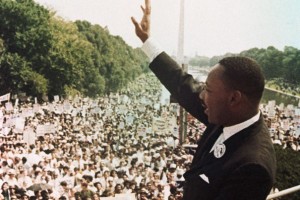
Read this thoughtful essay by Carol Bragg, a local person who has worked for peace for many years in our little state. She focuses on MLK’s ideas about making nonviolence a way of life for each of us. King felt that nonviolence was important for individuals as well as a medium for social change
The year 2014 is the 50th anniversary of the Rev. Martin Luther King Jr.’s receiving the Nobel Peace Prize. Mr. King was puzzled why he was awarded this prize when the work to combat racial injustice was incomplete. He concluded that it was the movement’s commitment to nonviolence that was being honored. Long before 1964, he had accepted nonviolence not only as a method of social change but also a way of life. He urged that nonviolence be experimented with at every level of human existence, including in international relations. Although there have been major social-change movements in this country that have used nonviolent methods, little has been done to encourage individuals to adopt nonviolence as a way of life. When acts of violence have become so commonplace as to seem normal, we need to teach nonviolence to curb the violence that plagues society: child abuse and neglect, domestic violence, gang activity, sexual assault, bullying and harassment, date rape, gun violence, racial and religious prejudice, homophobia and road rage, among others. We are a nation on edge, fear-ridden, angry, too willing to settle scores, and seemingly incapable of resolving conflicts. We’ve forgotten how to live together harmoniously. There are numerous programs that address different types of violence, but we lack a comprehensive strategy to reduce all forms of violence, one that makes us resilient in the face of adversity and despair and willing to rule out the use of violence against ourselves and others. If we want a peaceful society, the most logical solution is to teach alternatives to violence, starting at a very young age and continuing through secondary education. Every child who graduates from high school should be as proficient in the principles and skills of nonviolence as he or she are in math, science or English. We tend to distance ourselves from the perpetrators of violence, writing them off as monsters or mentally ill. But all of us have within us the potential for violence. It is human to feel anger, often the trigger for acts of violence. Even the saints are not free of this emotion. Gandhi, once furious that his wife refused to clean the latrine, exploded at her, ordering her to leave the ashram. Gandhi described anger as a form of energy, not unlike electricity. Uncontrolled, it comes out like a bolt of lightning, destroying everything in its path. But, like electricity, it can be harnessed for good. We all need to learn techniques for anger management and converting our anger into a catalyst for positive change. As human beings, we all need a sense of self-worth and belonging. If our self-esteem is damaged by poor parenting, a teacher who makes us feel inferior, or peers who taunt us, we feel estranged from ourselves and others. Psychologist Erich Fromm, in “The Art of Loving,” states that separation produces anxiety and absolute separation produces insanity. We need healthy self-esteem and respect for others to avoid the alienation that can drive people to acts of violence. No one is born with an innate knowledge of how to resolve conflicts. We learn from observation or training that the courageous fight back physically, that heroes are those who use violence to conquer evil, and that violence can only be defeated with more violence. We need to learn alternative approaches to conflict that don’t demonize people and instead produce win-win solutions that build strong relationships and communities. Alternatives to violence curriculum should include, among other things, reverence for life and for the planet, principles of nonviolence, self-worth and other respect, the different levels of love, anger management, fear reduction, compassion, forgiveness, respect for religious and cultural diversity, mediation and conflict resolution, the history of nonviolence in America, the Hegelian approach to seeking the truth, consensus building, nonviolent communication, the concept of the wounded healer, and nonviolence as a means of pursuing social justice that results in reconciliation. This year, America should resolve to address its epidemic of violence by launching universal education in anger management and the principles and skills of nonviolence. The first step should be creating a national and nationwide conversation around the importance of incorporating this education into schools, public and private, grades K-12. Over a generation or two, the benefits to our families, in our workplaces, in our faith communities, in government and on the streets of America can be immense. If we can plumb the depths of the ocean and explore the far reaches of space, if we can rid the planet of once fatal diseases and unlock the mysteries of the human brain, we can learn how to live together without violence. Like pioneers, we can cross the threshold of a new frontier where the age-old problem of human violence is substantially eradicated. Carol Bragg, of Seekonk, recently worked as a member of the Civil Rights Scholars Team for the JPMorgan Chase/Martin Luther King Jr. Center for Nonviolent Social Change project, digitizing Mr. King’s papers for Web display. http://ireader.olivesoftware.com/Olive/iReader/ProvidenceJournalPress/SharedArticle.ashx?document=TPJ\2014\01\02&article=Ar01500
A Pursuing a world of peace is achievable and possible.